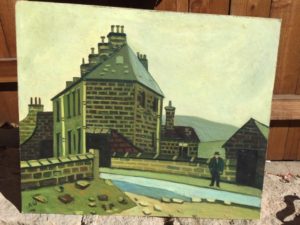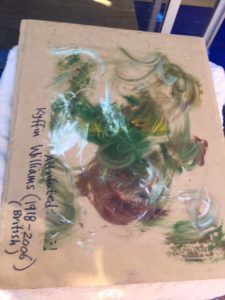 LS found this Welsh painting in a small antique shop in Franklin Township, Sussex County NJ years ago. He thought it perfect for his brother’s new lake house. But on presentation his brother hated it.
LS found this Welsh painting in a small antique shop in Franklin Township, Sussex County NJ years ago. He thought it perfect for his brother’s new lake house. But on presentation his brother hated it.
So, LS stuck this painting in his attic until a few months ago when he purchased a cabin in Lake Arrowhead. The piece reminded LS of the work of L S Lowry (1887-1976) a British Naïve artist who painted those smoky and dire towns of Northwest England. He peopled them with his trademark “matchstick men.”
LS’s painting, signed with “KW” in the bottom left corner, cost $40. On the back someone deemed it the work of Kyffin Williams (1918-2006). Let’s hope so.
Kyffin Williams and 20th century Welsh art
 Art historians regard Williams the defining presence in 20th century Welsh art. He himself might feel saddened that the attribution on the back says British and not WELSH. Although for 30 years he served as a painting master in high end London schools. He retired at Pwllfanogl, Llanfairpwll, on the Isle of Anglesey, near the Menai Straits overlooking Snowdonia, close to his birthplace.
Art historians regard Williams the defining presence in 20th century Welsh art. He himself might feel saddened that the attribution on the back says British and not WELSH. Although for 30 years he served as a painting master in high end London schools. He retired at Pwllfanogl, Llanfairpwll, on the Isle of Anglesey, near the Menai Straits overlooking Snowdonia, close to his birthplace.
Becoming a professional artist fairly late in life, while facing a British Army Medic he suffered from an epileptic fit and they told him to continue painting instead. He threw himself into the craft.
Later, after he won the Winston Churchill Fellowship, he traveled to Patagonia to paint the Welsh settlement of Y Wladfa. He received the OBE award, and then became knighted in 1999.
The National Library of Wales holds a major selection of his works. He wrote: (no other country) “touches the mood…of melancholy that is in most Welshmen, a melancholy derived from the dark hills, the heavy clouds, and the enveloping sea mist.” Scholars say he knew the Welsh landscape so well that when he painted a mountain, he knew what sat on the other side.
Williams said that painting was not just about making images, but that a big part of his creative process included love and mood. A painter must love his subject matter, because to communicate that subject to a viewer, one must love it. He claimed that obsession became a greater asset than talent, and painted he did, in all weathers, with a palette knife.
Hallmarks of a Welsh Painting by Williams
LS’s painting depicts a Welsh scene, a certain color of the grey cold climate, the hard edge of stone, and a palette knife technique. And indeed, Williams signed with just KW.
How to authenticate this painting? Since Williams was a beloved and established career artist, he likely sold through galleries, and various museums either collected or received his works as gifts. Galleries are the way to go. Museums usually can’t offer opinions. I researched the galleries that once sold him. I tried Oriel Ynysmon, in Williams’ town of Llangefni, and emailed the director a photo of this Welsh painting.
The National Library of Wales in Aberystwyth held a retrospective show to honor the centenary of his birth (1918) in 2018. Find a contact for the director, Lona Mason, a photo. Another lead, David Wynn Meredith, chairs the Sir Kyffin Williams Trust. These experts can get you close to answering questions of authenticity.
When you get confirmation, next, research the values of authentic work at auction by using a compilation service like ArtPrice or ArtNet to find out the possible worth of your $40 painting. This will indicate the BEST auction houses for the work, should you wish to sell.
A few weeks ago, Bonham’s London estimated the value of a Williams seascape between $13K and $20K. Even during the Pandemic, Williams’ sales are great. Sotheby’s sold a street scene for $50K. Values have ranged from $20K to $40K a painting. In fact, a trend during the Pandemic is to hold specific themed auctions. In Williams’ case, I see his work selling well at Modern British Art sales. During this crisis we see a traditional regional art sells WELL in general.
Williams died a wealthy man, having made a fortune with his palette knife, and he gave liberally to art charitable causes in Wales. For this reason people remain interested in keeping the values of his work strong. That means research should be easy, LS. I’m rooting for you that this $40 painting turns into a $40K painting.
Pingback: Do You Own An Original Painting? - Elizabeth Appraisals